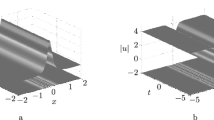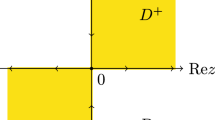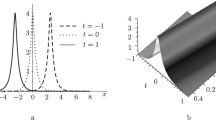Abstract
We apply the inverse scattering transformation to the generalized mixed nonlinear Schrödinger equation with nonzero boundary condition at infinity. The scattering theories are investigated. In the direct problem, we analyze the analyticity, symmetries, and asymptotic behaviors of the Jost solutions and the scattering matrix, and the properties of the discrete spectrum. In the inverse problem, an appropriate Riemann–Hilbert problem is formulated. By solving the problem, we obtain the reconstruction formula, the trace formula, and the “theta” condition. In the reflectionless case, a complicated integral factor is derived, which is a key ingredient of the explicit expression for \(N\)-soliton solutions. Using the \(N\)-soliton formula, we discuss the abundant dynamical features of the solution and its phases at different parameter values.






Similar content being viewed by others
References
A. Hasegawa and F. Tappert, “Transmission of stationary nonlinear optical physics in dispersive dielectric fibers. I. Anomalous dispersion,” Appl. Phys. Lett., 23, 142–144 (1972).
G. P. Agrawal, Nonlinear Fiber Optics, Academic Press, New York (2007).
D. J. Benney and A. C. Newell, “Propagation of nonlinear wave envelopes,” J. Math. Phys., 46, 133–139 (1967).
F. Dalfovo, S. Giorgini, L. P. Pitaevskii, and S. Stringari, “Theory of Bose–Einstein condensation in trapped gases,” Rev. Modern Phys., 71, 463–512 (1999); ar**v: cond-mat/9806038.
R. Hirota, The Direct Method in Soliton Theory (Cambridge Tracts in Mathematics, Vol. 155), Cambridge Univ. Press, Cambridge (2004).
Y. Li, X. Gu, and M. Zou, “Three kinds of Darboux transformation for the evolution equation which connect with A.K.N.S. eigenvalue problem,” Acta Math. Sin. (N. S.), 3, 143–151 (1987).
S. P. Novikov, S. V. Manakov, L. P. Pitaevskii, and V. E. Zakharov, Theory of Solitons. The Inverse Scattering Methods, Consultants Bureau, New York (1984).
M. J. Ablowitz and P. A. Clarkson, Solitons, Nonlinear Evolution Equations and Inverse Scattering, Cambridge Univ. Press, Cambridge (1991).
V. E. Zakharov and A. B. Shabat, “Exact theory of two-dimensional self-focusing and one-dimensional self-modulation of waves in nonlinear media,” Sov. Phys. JETP, 34, 62–69 (1972).
Y.-C. Ma and M. J. Ablowitz, “The periodic cubic Schrödinger equation,” Stud. Appl. Math., 65, 113–158 (1981).
D. H. Peregrine, “Water waves, nonlinear Schrödinger equations and their solutions,” J. Austral. Math. Soc. Ser. B, 25, 16–43 (1983).
L. D. Faddeev and L. A. Takhtajan, Hamiltonian Methods in the Theory of Solitons, Springer, Berlin (1987).
T. Brabec and F. Krausz, “Intense few-cycle laser fields: Frontiers of nonlinear optics,” Rev. Modern Phys., 72, 545–591 (2000).
F. Krausz and M. Ivanov, “Attosecond physics,” Rev. Modern Phys., 81, 163–234 (2009).
R. S. Johnson, “On the modulation of water waves in the neighbourhood of \(kh\approx 1.363\),” Proc. Roy. Soc. London Ser. A, 357, 131–141 (1977).
Y. Kodama, “Optical solitons in a monomode fiber,” J. Stat. Phys., 39, 597–614 (1985).
P. A. Clarkson and J. A. Tuszynski, “Exact solutions of the multidimensional derivative nonlinear Schrödinger equation for many-body systems of criticality,” J. Phys. A: Math. Gen., 23, 4269–4288 (1990).
A. Rogister, “Parallel propagation of nonlinear low-frequency waves in high-\(\beta\) plasma,” Phys. Fluids, 14, 2733–2739 (1971).
D. J. Kaup and A. C. Newell, “An exact solution for a derivative nonlinear Schrödinger equation,” J. Math. Phys., 19, 798–801 (1978).
E. Mjolhus, “On the modulational instability of hydromagnetic waves parallel to the magnetic field,” J. Plasma Phys., 16, 321–334 (1976).
N. Tzoar and M. Jain, “Self-phase modulation in long-geometry optical waveguides,” Phys. Rev. A, 23, 1266–1270 (1981).
D. Anderson and M. Lisak, “Nonlinear asymmetric self-phase modulation and self-steepening of pulses in long optical waveguides,” Phys. Rev. A, 27, 1393–1398 (1983).
H. H. Chen, Y. C. Lee, and C. S. Liu, “Integrability of nonlinear Hamiltonian systems by inverse scattering method,” Phys. Scr., 20, 490–492 (1979).
V. S. Gerdjikov and M. I. Ivanov, “A quadratic pencil of general type and nonlinear evolution equations. II. Hierarchies of Hamiltonian structures,” Bulg. J. Phys., 10, 130–143 (1983).
J. Moses, B. A. Malomed, and F. W. Wise, “Self-steepening of ultrashort optical pulses without self-phase-modulation,” Phys. Rev. A, 76, 021802, 4 pp. (2007).
A. Kundu, “Landau–Lifshitz and higher-order nonlinear systems gauge generated from nonlinear Schrödinger-type equations,” J. Math. Phys., 25, 3433–3438 (1984).
Y. J. **ang, X. Y. Dai, S. C. Wen, J. Guo, and D. Y. Fan, “Controllable Raman soliton self-frequency shift in nonlinear metamaterials,” Phys. Rev. A, 84, 033815, 7 pp. (2011).
A. Choudhuri and K. Porsezian, “Dark-in-the-Bright solitary wave solution of higher-order nonlinear Schrödinger equation with non-Kerr terms,” Opt. Commun., 285, 364–367 (2012).
P. A. Clarkson and C. M. Cosgrove, “Painlevé analysis of the non-linear Schrödinger family of equations,” J. Phys. A: Math. Gen., 20, 2003–2024 (1987).
S. Kakei, N. Sasa, and J. Satsuma, “Bilinearization of a generalized derivative nonlinear Schrödinger equation,” J. Phys. Soc. Japan, 64, 1519–1523 (1995); ar**v: solv-int/9501005.
X. Lü, “Soliton behavior for a generalized mixed nonlinear Schrödinger model with \(N\)-fold Darboux transformation,” Chaos, 23, 033137, 8 pp. (2013).
D. Qiu and Q. P. Liu, “Darboux transformation of the generalized mixed nonlinear Schrödinger equation revisited,” Chaos, 30, 123111, 17 pp. (2020).
X. Lü and M. Peng, “Systematic construction of infinitely many conservation laws for certain nonlinear evolution equations in mathematical physics,” Commun. Nonlinear Sci. Numer. Simulat., 18, 2304–2312 (2013).
L. Wang, D.-Y. Jiang, F.-H. Qi, Y.-Y. Shi, and Y.-C. Zhao, “Dynamics of the higher-order rogue waves for a generalized mixed nonlinear Schrödinger model,” Commun. Nonlinear Sci. Numer. Simulat., 42, 502–519 (2017).
B. Yang, J. Chen, and J. Yang, “Rogue waves in the generalized derivative nonlinear Schrödinger equations,” J. Nonlinear Sci., 30, 3027–3056 (2020); ar**v: 1912.05589.
J. K. Yang, Nonlinear Waves in Integrable and Nonintegrable Systems (Mathematical Modeling and Computation, Vol. 16), SIAM, Philadelphia, PA (2010).
P. Deift and X. Zhou, “A steepest descent method for oscillatory Riemann–Hilbert problems,” Ann. Math., 137, 295–368 (1993).
G. Biondini and G. Kovăcič, “Inverse scattering transform for the focusing nonlinear Schrödinger equation with nonzero boundary conditions,” J. Math. Phys., 55, 031506, 22 pp. (2014).
M. Pichler and G. Biondini, “On the focusing non-linear Schrödinger equation with non-zero boundary conditions and double poles,” IMA J. Appl. Math., 82, 131–151 (2017).
G. Biondini and D. K. Kraus, “Inverse scattering transform for the defocusing Manakov system with nonzero boundary conditions,” SIAM J. Math. Anal., 47, 706–757 (2015).
B. Prinari, M. J. Ablowitz, and G. Biondini, “Inverse scattering transform for the vector nonlinear Schrödinger equation with nonvanishing boundary conditions,” J. Math. Phys., 47, 063508, 33 pp. (2006).
G. Biondini, D. K. Kraus, and B. Prinari, “The three-component defocusing nonlinear Schrödinger equation with nonzero boundary conditions,” Commun. Math. Phys., 348, 475–533 (2016); ar**v: 1511.02885.
G. Zhang and Z. Yan, “The derivative nonlinear Schrödinger equation with zero/nonzero boundary conditions: Inverse scattering transforms and \(N\)-double-pole solutions,” J. Nonlinear Sci., 30, 3089–3127 (2020).
Z. Zhang and E. Fan, “Inverse scattering transform for the Gerdjikov-Ivanov equation with nonzero boundary conditions,” Z. Angew. Math. Phys., 71, 149, 28 pp. (2020).
Y. Yang and E. Fan, “Riemann–Hilbert approach to the modified nonlinear Schrödinger equation with non-vanishing asymptotic boundary conditions,” ar**v: 1910.07720.
L.-L. Wen and E.-G. Fan, “The Riemann–Hilbert approach to focusing Kundu–Eckhaus equation with non-zero boundary conditions,” Modern Phys. Lett. B, 34, 2050332, 20 pp. (2020); ar**v: 1910.08921.
N. Guo and J. Xu, “Inverse scattering transform for the Kundu–Eckhaus equation with nonzero boundary conditions,” ar**v: 1912.11424.
N. Guo, J. Xu, L. Wen, and E. Fan, “Rogue wave and multi-pole solutions for the focusing Kundu–Eckhaus equation with nonzero background via Riemann–Hilbert problem method,” Nonlinear Dyn., 103, 1851–1868 (2021).
Funding
This work is supported by the National Natural Science Foundation of China (Grant Nos. 11871471 and 11931017), the Yue Qi Outstanding Scholar Project, China University of Mining and Technology, Bei**g (Grant No. 00-800015Z1177).
Author information
Authors and Affiliations
Corresponding author
Ethics declarations
The authors declare no conflicts of interest.
Additional information
Translated from Teoreticheskaya i Matematicheskaya Fizika, 2021, Vol. 209, pp. 274–304 https://doi.org/10.4213/tmf10067.
Rights and permissions
About this article
Cite this article
Qiu, D., Lv, C. Riemann–Hilbert approach and \(N\)-soliton solutions of the generalized mixed nonlinear Schrödinger equation with nonzero boundary conditions. Theor Math Phys 209, 1552–1578 (2021). https://doi.org/10.1134/S0040577921110052
Received:
Revised:
Accepted:
Published:
Issue Date:
DOI: https://doi.org/10.1134/S0040577921110052




